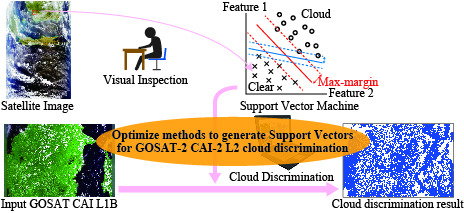The Impact of Different Support Vectors on GOSAT-2 CAI-2 L2 Cloud Discrimination
Abstract
:1. Introduction
- Perform supervised learning using SVM in a high-dimensional feature space of the training samples extracted from training images to determine the decision function, thresholds, and support vectors (SV).
- Perform cloud discrimination for input images, using the decision function, thresholds, and SV.
- We examined the impact of the choice of the collection period for the training data.
- We examined the impact of different SV generation procedures.
2. Tools and Methodology
2.1. Study Area and Data
2.2. SV Preparation Procedure
- Extract clear training samples:Typical non-cloud-contaminated pixels were extracted as “clear training samples” by visual inspection from MOD021KM products for various land cover types.
- Automatically extract cloud training samples:“Cloud training samples” were automatically extracted under the assumption that pixels that were at sufficient distances from the clear training samples, based on Mahalanobis distances, were cloud-contaminated pixels.
- Decide decision function, thresholds, and SV:Supervised learning was performed using SVM, in a high-dimensional feature space for the extracted training samples, to determine the decision function, thresholds, and SV.
- Perform cloud discriminationCloud discrimination for input CAI L1B images was performed using the decision function, thresholds, and SV.
2.3. Analytical Procedure
3. Results
3.1. Results for Various Time Periods
3.2. Results Obtained for Various SV Generation Procedures
4. Discussion
4.1. Relationshp between the Seasonal Variation and the Seasonal Change of Surface Reflectance
4.2. Cause of High D.A. in Alaska and Low D.A. in Thailand and Borneo Island
5. Conclusions
Acknowledgments
Author Contributions
Conflicts of Interest
References
- GOSAT-2 Project at the National Institute for Environmental Studies, about GOSAT-2. Available online: www.gosat-2.nies.go.jp (accessed on 10 October 2017).
- Algorithm Theoretical Basis Document (ATBD) for CO2 and CH4 Column Amounts Retrieval from GOSAT TANSO-FTS SWIR. Available online: https://data2.gosat.nies.go.jp/doc/documents/ATBD_FTSSWIRL2_V2.0_en.pdf (accessed on 10 October 2017).
- Ackerman, S.; Strabala, K.; Menzel, P.; Frey, R.; Moeller, C.; Guemley, L. Discriminating clear sky from clouds with MODIS. J. Geophys. Res. 1998, 103, 32141–32157. [Google Scholar] [CrossRef]
- Discriminating Clear-Sky from Cloud with MODIS Algorithm Theoretical Basis Document (MOD35). Available online: http://modis-atmos.gsfc.nasa.gov/_docs/MOD35_ATBD_Collection6.pdf (accessed on 24 November 2017).
- Ishida, H.; Nakajima, T.Y. Development of an unbiased cloud detection algorithm for a spaceborne multispectral imager. J. Geophys. Res. 2009, 114. [Google Scholar] [CrossRef]
- Ishida, H.; Nakajima, T.Y.; Yokota, T.; Kikuchi, N.; Watanabe, H. Investigation of GOSAT TANSO-CAI cloud screening ability through an intersatellite comparison. J. Appl. Meteorol. Climatol. 2011, 50, 1571–1586. [Google Scholar] [CrossRef]
- Uchino, O.; Kikuchi, N.; Sakai, T.; Morino, I.; Yoshida, Y.; Nagai, T.; Shimizu, A.; Shibata, T.; Yamazaki, A.; Uchiyama, A.; et al. Influence of aerosols and thin cirrus clouds on the GOSAT-observed CO2: A case study over Tsukuba. Atmos. Chem. Phys. 2012, 12, 3393–3404. [Google Scholar] [CrossRef]
- Vapnik, V.; Lerner, A. Pattern recognition using generalized portrait method. Autom. Remote Control 1963, 24, 774–780. [Google Scholar]
- Ishida, H.; Oishi, Y.; Morita, K.; Moriwaki, K.; Nakajima, T.Y. Development of a support vector machine based cloud detection method for MODIS with the adjustability to various conditions. Remote Sens. Environ. 2017, in press. [Google Scholar]
- Oishi, Y.; Hiraki, K.; Yokota, Y.; Sawada, Y.; Murakami, K.; Kamei, A.; Yoshida, Y.; Matsunaga, T. Usability evaluation of GPU for GOSAT-2 TANSO-CAI-2 L2 cloud flag processing. J. Remote Sens. Soc. Jpn. 2015, 35, 173–183, (In Japanese with English Abstract). [Google Scholar] [CrossRef]
- Oishi, Y.; Nagao, T.M.; Ishida, H.; Nakajima, T.Y.; Matsunaga, T. Preliminary study of a method using the GOSAT-2 CAI-2 cloud discrimination for screening of cloud-contaminated FTS-2 data. J. Remote Sens. Soc. Jpn. 2015, 35, 299–306, (In Japanese with English Abstract). [Google Scholar] [CrossRef]
- Taylor, T.E.; O’Dell, C.W.; O’Brien, D.M.; Kikuchi, N.; Yokota, T.; Nakajima, T.Y.; Ishida, H.; Crisp, D.; Nakajima, T. Comparison of cloud-screening methods applied to GOSAT near-infrared spectra. IEEE Trans. Geosci. Remote Sens. 2012, 50, 295–309. [Google Scholar] [CrossRef]
- Oishi, Y.; Nakajima, T.Y.; Matsunaga, T. Difference between forward- and backward-looking bands of GOSAT-2 CAI-2 cloud discrimination using Terra MISR data. Int. J. Remote Sens. 2016, 37, 1115–1126. [Google Scholar] [CrossRef]
- The World’s Cities in 2016. Available online: http://www.un.org/en/development/desa/population/publications/pdf/urbanization/the_worlds_cities_in_2016_data_booklet.pdf (accessed on 7 November 2017).
- NIES GOSAT TANSO-CAI Level 3 Data Product Format Description. Available online: https://data2.gosat.nies.go.jp/GosatDataArchiveService/doc/GU/GOSAT_ProductDescription_33_CAIL3_V3.01_en.pdf (accessed on 17 November 2017).
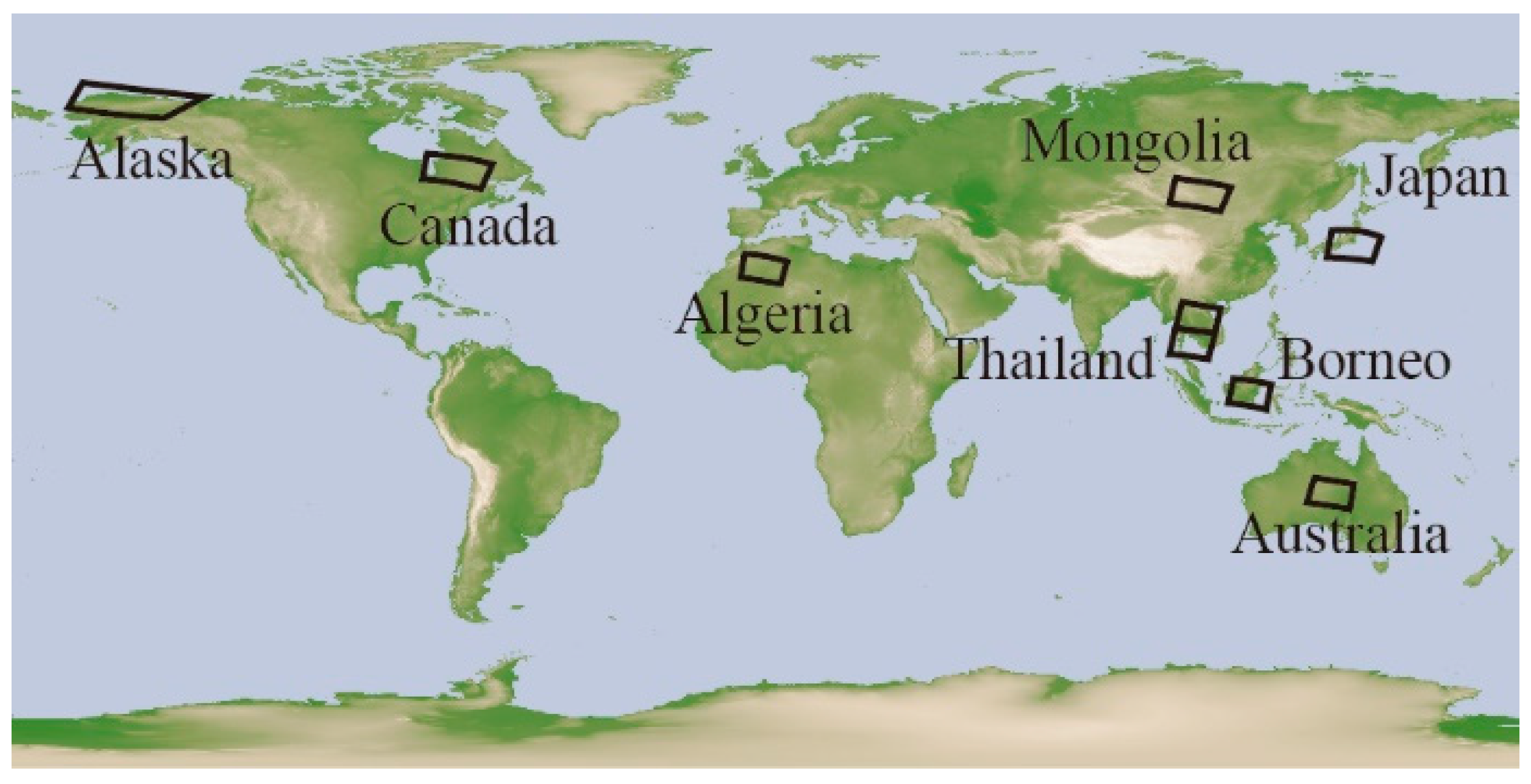
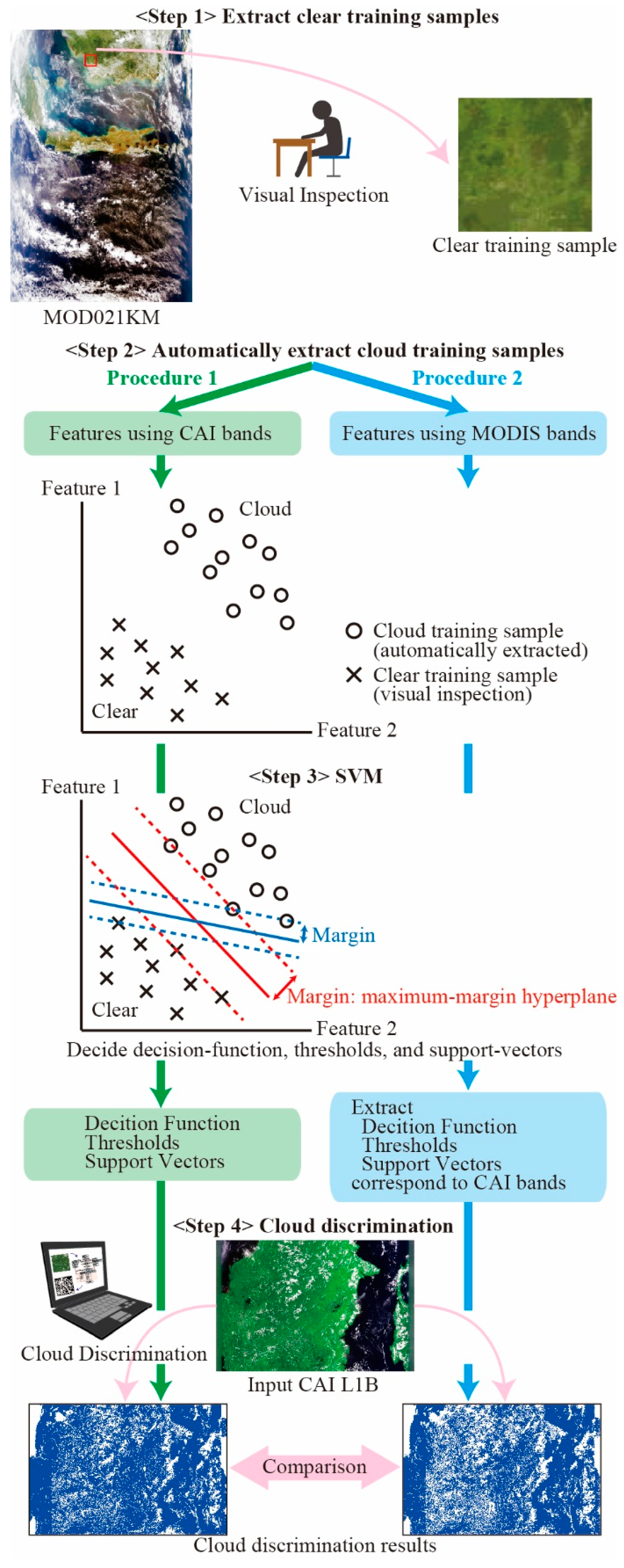
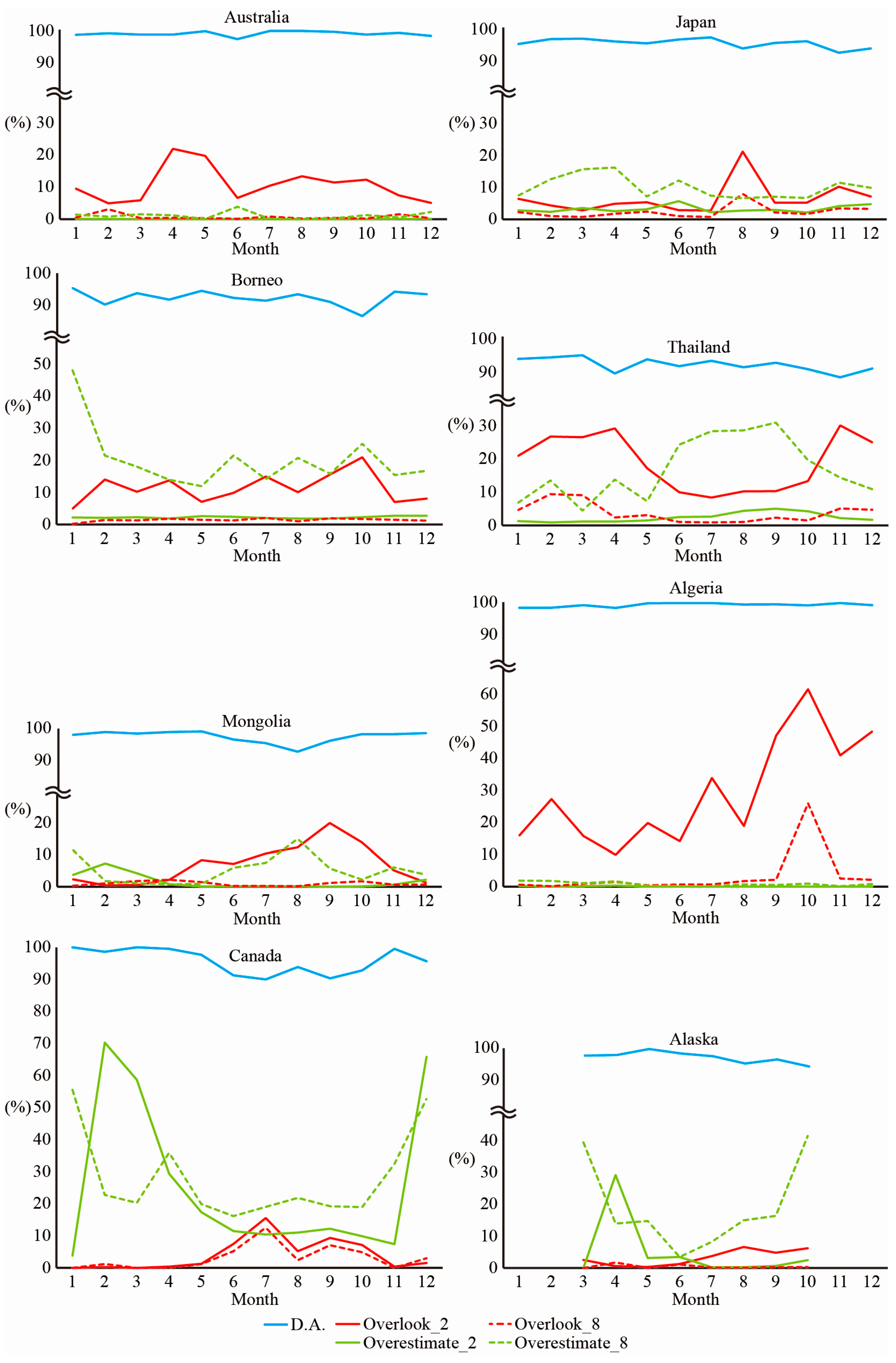
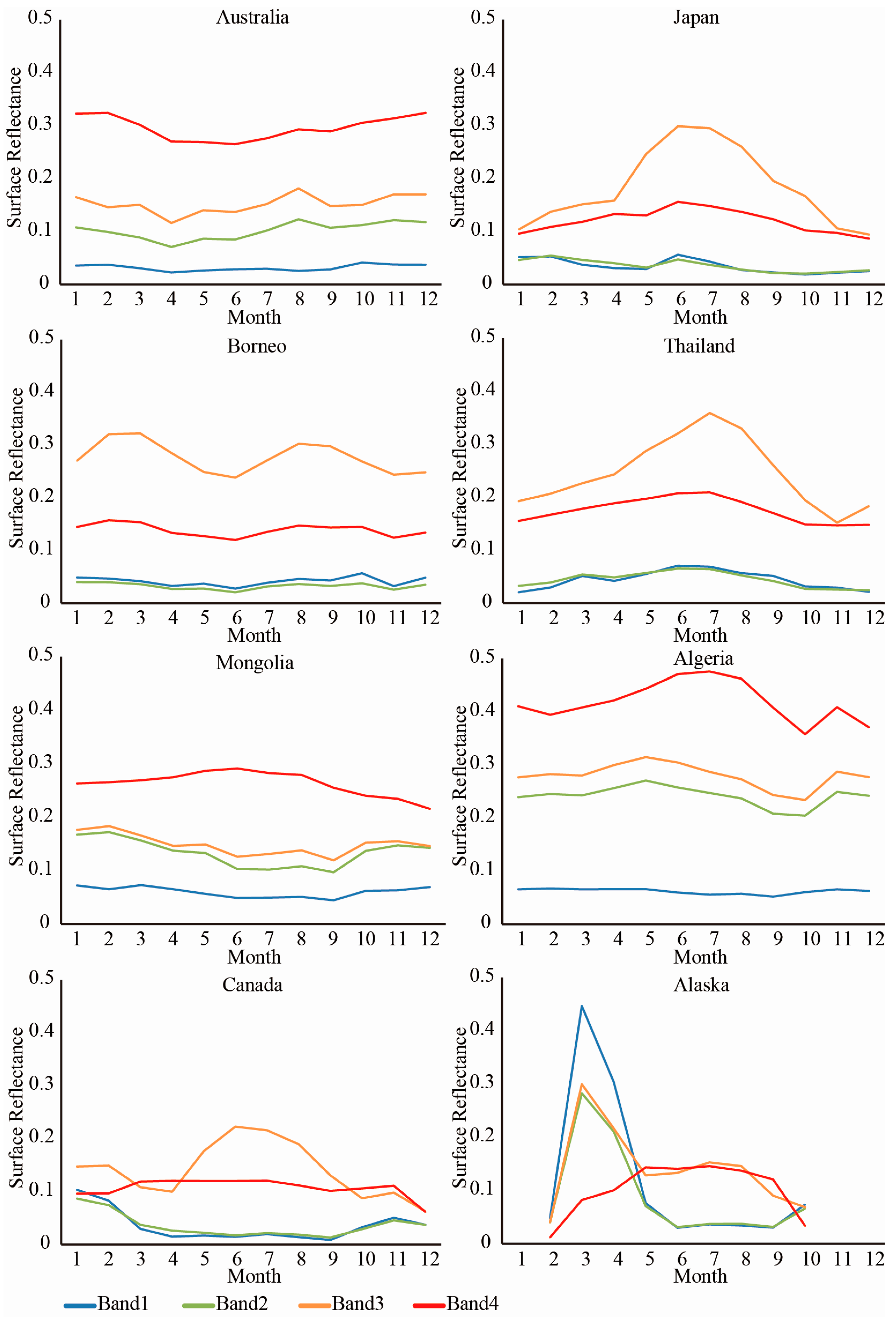
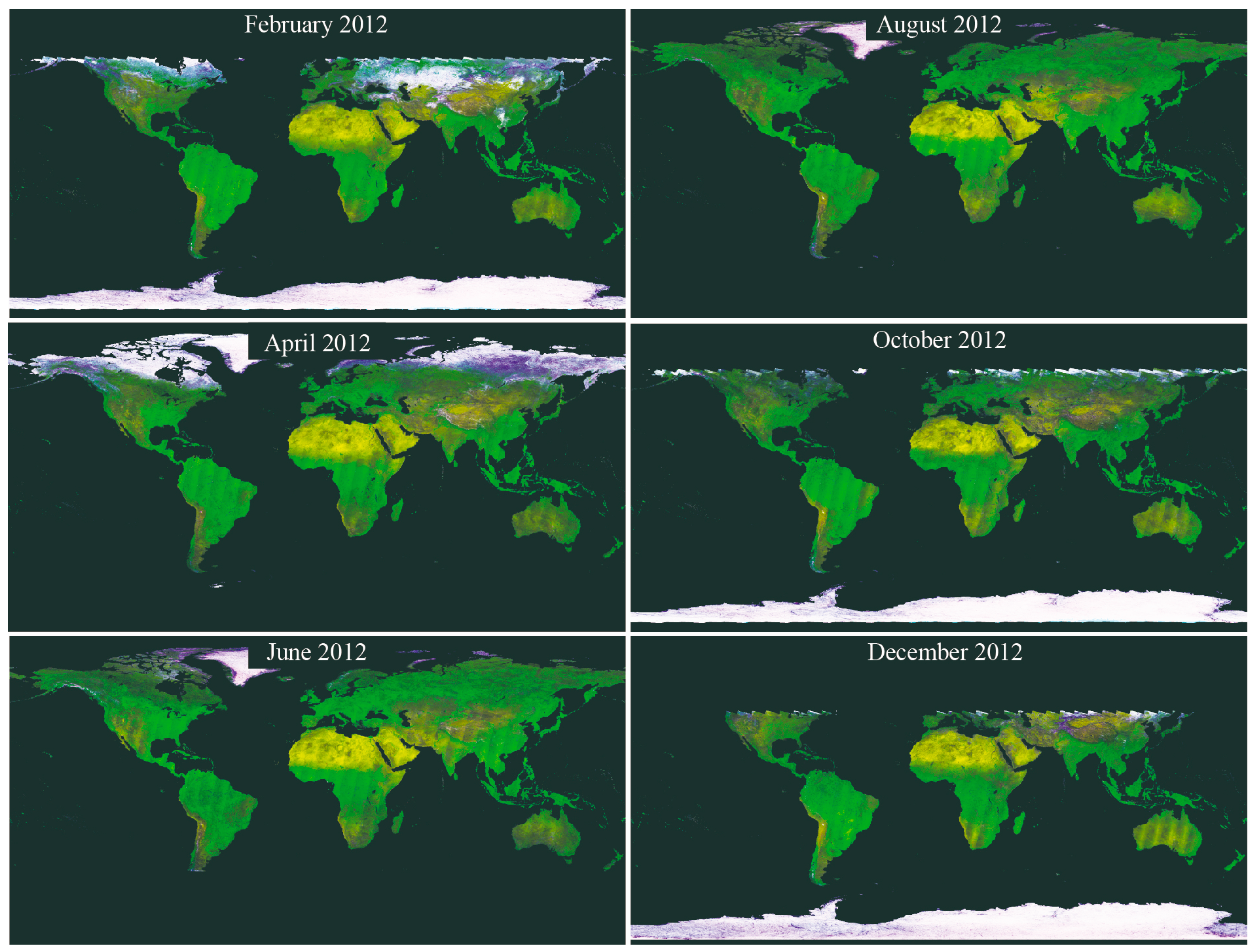
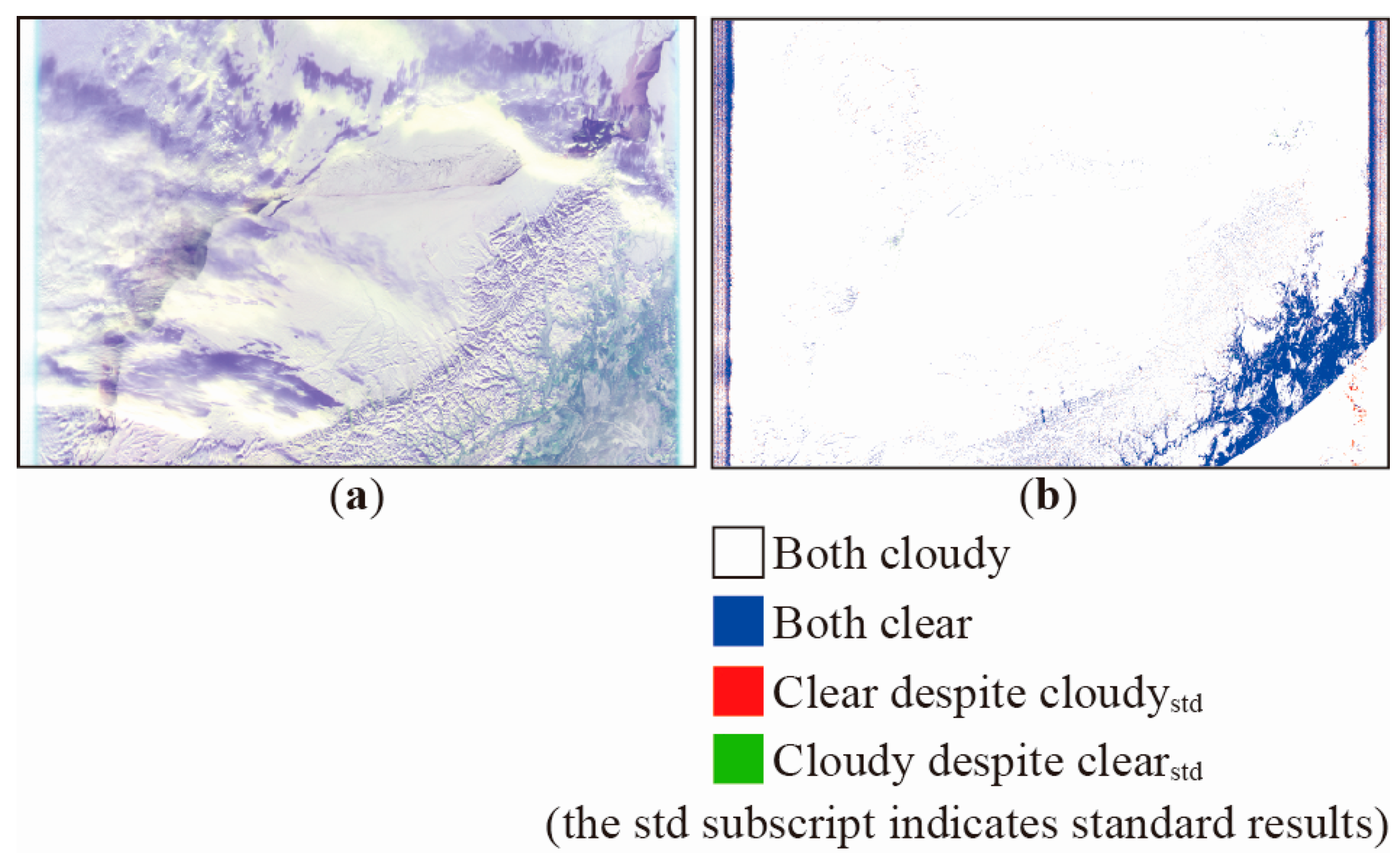

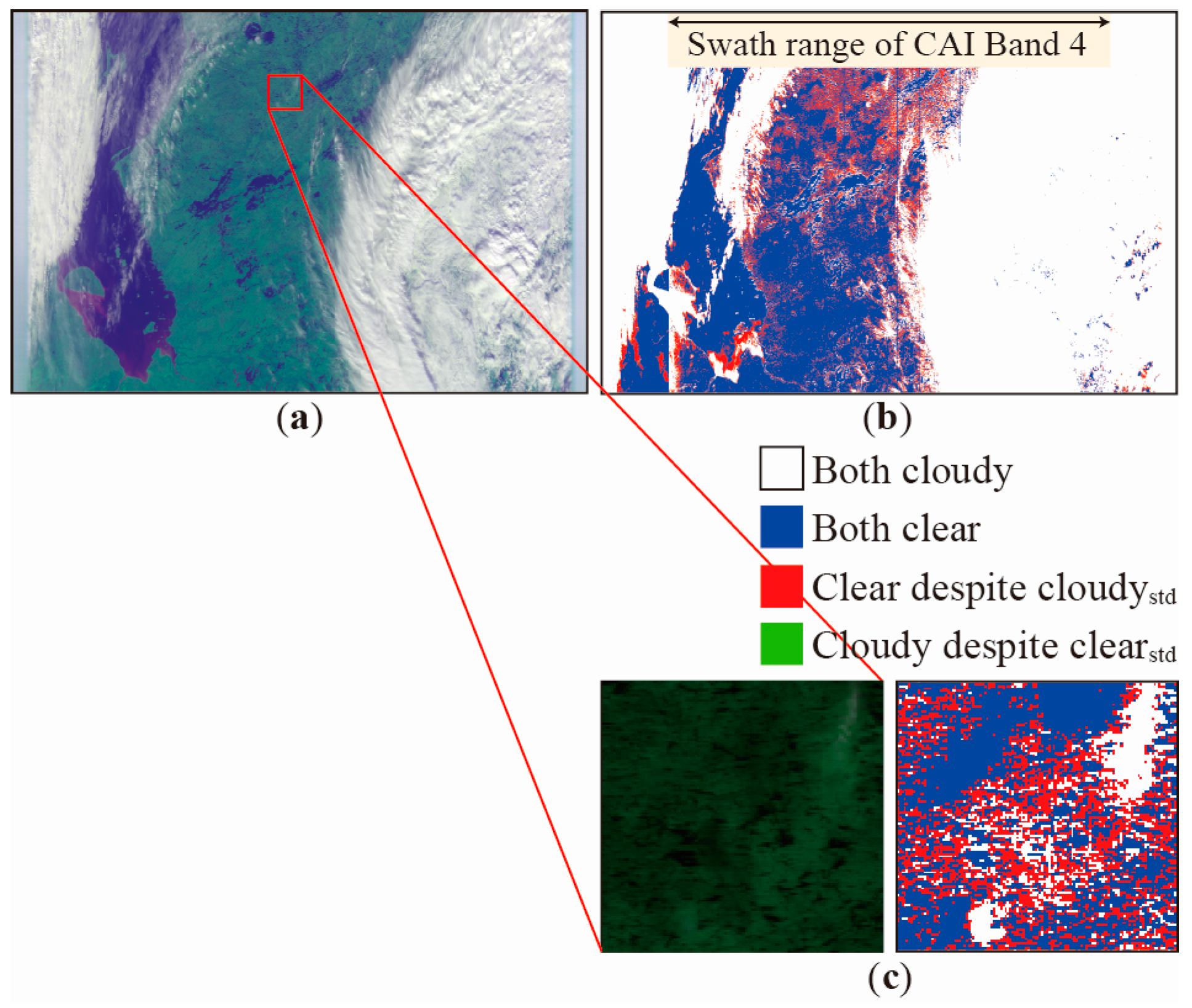
| Specifications of GOSAT CAI | ||||
| Band | Spectral Coverage (μm) | Spatial Resolution (m) | Swath (km) | |
| 1 | 0.370–0.390 | 500 | 1000 | |
| 2 | 0.664–0.684 | 500 | 1000 | |
| 3 | 0.860–0.880 | 500 | 1000 | |
| 4 | 1.555–1.645 | 1500 | 750 | |
| Specifications of GOSAT-2 CAI-2 | ||||
| Band | Spectral Coverage (μm) | Spatial Resolution (m) | Viewing Angle (°) | Swath (km) |
| 1 | 0.333–0.353 | 460 | +20 (Forward) | 920 |
| 2 | 0.433–0.453 | |||
| 3 | 0.664–0.684 | |||
| 4 | 0.859–0.879 | |||
| 5 | 1.585–1.675 | 920 | ||
| 6 | 0.370–0.390 | 460 | −20 (Backward) | |
| 7 | 0.540–0.560 | |||
| 8 | 0.664–0.684 | |||
| 9 | 0.859–0.879 | |||
| 10 | 1.585–1.675 | 920 | ||
| Location (CAI Path_Frame) | Data Period | Land Cover |
|---|---|---|
| Australia (4_35) | 3 April 2012–3 March 2014 | Open shrublands |
| Japan (5_25) | 1 April 2012–1 March 2014 | Mixed forests |
| Borneo (7_31) | 3 April 2012–3 March 2014 | Evergreen broadleaf forest |
| Thailand 1 (9_28) | 2 April 2012–2 March 2014 | Cropland/natural vegetation |
| Thailand 2 (9_29) | 2 April 2012–2 March 2014 | Cropland/natural vegetation |
| Mongolia (22_26) | 3 April 2012–3 March 2014 | Grasslands |
| Algeria (22_26) | 3 April 2012–3 March 2014 | Barren or sparsely vegetated |
| Canada (32_22) | 1 April 2012–1 March 2014 | Evergreen needleleaf forest |
| Alaska (43_19) | 1 April 2012–1 March 2014 | Open shrublands |
| Features Using MODIS Bands | Features Using CAI Bands |
|---|---|
| NDSI | R0.66 |
| R0.66 | R0.87 |
| R0.87 | R0.87/R0.66 |
| R0.87/R0.66 | NDVI |
| NDVI | R0.87/R1.64 |
| T13.9 | |
| T13.3 − T11.0 | |
| Split window | |
| T11.0 − T8.6 | |
| T11.0 − T3.9 | |
| R1.38 | |
| R0.905/R0.935 | |
| R0.87/R1.64 | |
| R1.24/R0.55 |
| Location (CAI Path_Frame) | D.A. (%) | Overlook (%) | Overestimate (%) |
|---|---|---|---|
| Australia (4_35) | 99.4 (0.9) | 0.3 (0.3) | 0.8 (1.3) |
| Japan (5_25) | 97.3 (1.3) | 2.8 (2.3) | 3.2 (4.1) |
| Borneo (7_31) | 93.1 (4.6) | 2.4 (2.5) | 10.5 (11.9) |
| Thailand 1 (9_28) | 93.3 (4.5) | 6.7 (8.3) | 13.0 (18.0) |
| Thailand 2 (9_29) | 95.0 (2.0) | 6.8 (7.9) | 7.9 (9.8) |
| Mongolia (10_23) | 97.6 (2.1) | 1.1 (2.0) | 3.7 (3.9) |
| Algeria (22_26) | 99.3 (1.4) | 1.1 (3.0) | 0.7 (1.5) |
| Canada (32_22) | 96.7 (3.0) | 1.3 (3.0) | 15.6 (14.8) |
| Alaska (43_19) | 98.8 (0.8) | 1.1 (0.9) | 4.1 (7.3) |
© 2017 by the authors. Licensee MDPI, Basel, Switzerland. This article is an open access article distributed under the terms and conditions of the Creative Commons Attribution (CC BY) license (http://creativecommons.org/licenses/by/4.0/).
Share and Cite
Oishi, Y.; Ishida, H.; Nakajima, T.Y.; Nakamura, R.; Matsunaga, T. The Impact of Different Support Vectors on GOSAT-2 CAI-2 L2 Cloud Discrimination. Remote Sens. 2017, 9, 1236. https://doi.org/10.3390/rs9121236
Oishi Y, Ishida H, Nakajima TY, Nakamura R, Matsunaga T. The Impact of Different Support Vectors on GOSAT-2 CAI-2 L2 Cloud Discrimination. Remote Sensing. 2017; 9(12):1236. https://doi.org/10.3390/rs9121236
Chicago/Turabian StyleOishi, Yu, Haruma Ishida, Takashi Y. Nakajima, Ryosuke Nakamura, and Tsuneo Matsunaga. 2017. "The Impact of Different Support Vectors on GOSAT-2 CAI-2 L2 Cloud Discrimination" Remote Sensing 9, no. 12: 1236. https://doi.org/10.3390/rs9121236




